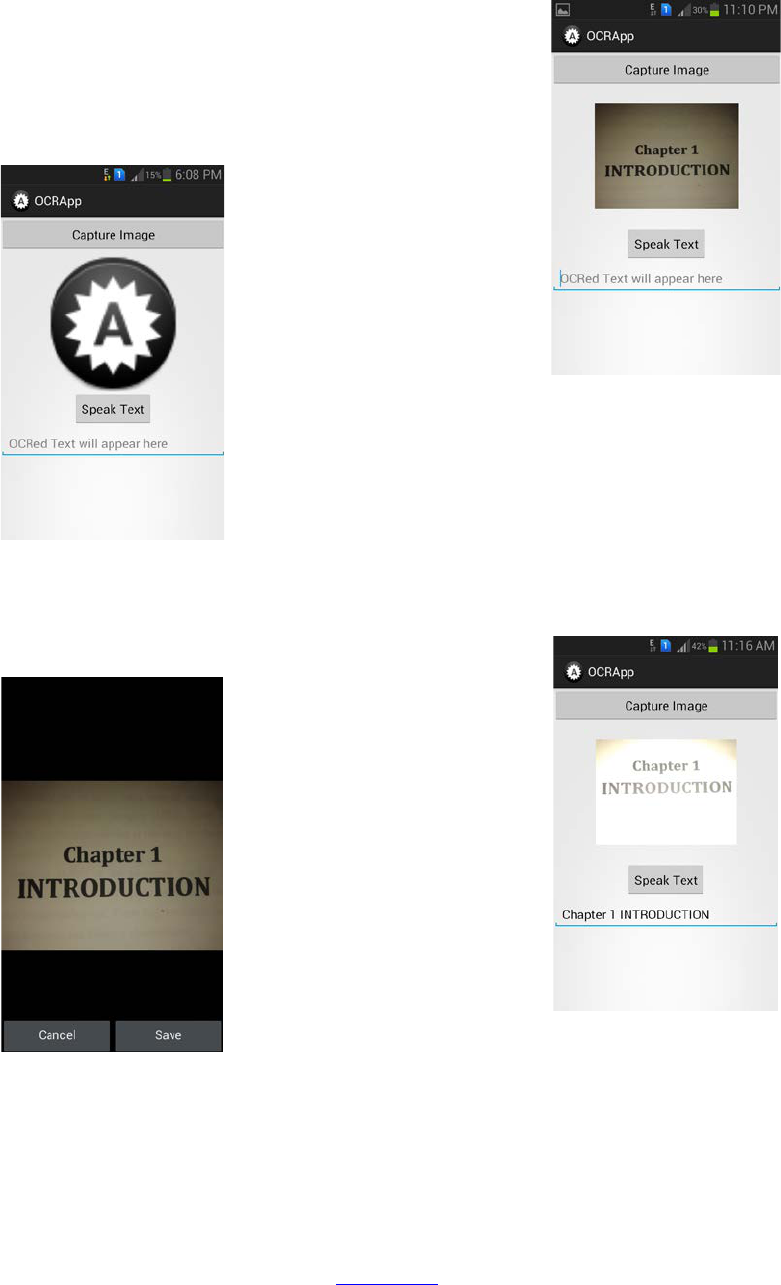
International Journal of Scientific & Engineering Research, Volume 6, Issue 11, November-2015 441
ISSN 2229-5518
IJSER © 2015
http://www.ijser.org
Text Detection and Recognition with
Speech Output in Mobile Application for
Assistance to Visually Challenged Person
1
Ms.Rupali D. Dharmale,
2
Dr. P. V. Ingole
Abstract- Now a day’s use of mobile is broadly increased every person possesses a mobile phone, in
which lots of application run. Using Android mobile phones we can help the visually challenged people by
providing easy reading of text boards and printed text information in the form of audio. Reading text from
printed text images and text boards is a challenging task for visually challenged persons. The proposed
system extracts and recognizes text from scene images and converts that recognized text into speech.
This application is very helpful and handy for visually challenged person. The novelty of this work is to
convert image containing text into speech.
Index Terms- Android, OCR, Text reading, Text to audio conversion, visually impaired person.
—————————— ——————————
1. Introduction
The number of visually impaired persons
is increasing due to uncontrolled diabetes, age
related causes, eye diseases, traffic accidents, and
other causes. Cataract is leading cause of
blindness and visual impairment. Mobile
applications that provide the support to visually
challenged person have become an essential
device in visually challenged person’s life.
Recent advances in mobile technology, digital
camera, computer vision and camera based
application make it possible to support visually
challenged persons by developing camera based
application that combine computer vision with
other existing technology such as optical
character recognition (OCR) system. With the
rapid development of camera-based applications
on smart phones and handy devices,
understanding the pictures taken by these devices
has gained growing attention from the computer
vision community in recent years which will be
helpful for these individuals. The main focus of
our research is that the visually challenged person
can get information about printed text, text
boards, scene text, hoardings, and instructions on
traffic sign boards in audio form. With this point
of view, the system design for a camera based
reading system that extract text from textual
board and identify the text characters from the
captured image and finally, textual information
will be converted into speech.
IJSER

International Journal of Scientific & Engineering Research, Volume 6, Issue 11, November-2015 442
ISSN 2229-5518
IJSER © 2015
http://www.ijser.org
To detect text information from image,
there exist many practical difficulties, such as
non-uniform backgrounds, due to the large
variations in character font, size, texture, color,
background, orientations, and many other
reasons. Text detection from scene/text camera
images is possible due to high resolution camera.
For extracting text information from image,
algorithms are required. However extracting text
information from captured text image is difficult
due to two main factors: 1) jumbled backgrounds
with noise, text and non-text part. 2) Random text
patterns such as character, fonts, sizes etc [1].
The frequency of occurrence of text in image is
very little, and limited number of text characters
is separate from background outliers. To solve
these difficult problems captured image text is
divided into two processes: text detection and
text recognition. Text detection is used to detect
image region containing text characters. It aims to
take out non- text background outliers [3]. Text
recognition is to convert pixel based text into
readable code. Optical character recognition is
the electronic conversion of images captured by a
digital camera of printed text into readable text.
OCR has a good performance when recognizing
machine-printed text in camera-based document
analysis. Optical Character Recognition, or OCR,
is a technology that converts different types of
printed documents, such as scanned paper
documents or images captured by a digital
camera into readable data.
2. Previous Work
In this section, we present some previous
research works for assisting visually challenged
people with text to speech technology. A number
of handy reading assistants have been designed
specifically for the visually challenged [4], [5],
[6], [7], [8], [9], [10], [11], [12], [13]. Michael
R.T.F. et al. proposed a system which operates
the mobile devices without using the keypad [12].
In [14], a camera-based assistive text reading
system to read text labels and product packaging
from hand-held objects. Text detection is to
detect regions in an image that contain text
characters. [1]. Methods of feature descriptor can
broadly be classified as Histogram of the oriented
gradient (HOG) descriptor, Scale invariant
feature transform (SIFT), Speeded up robust
features (SURF), Gradient location and oriented
histogram (GLOH) [1]. These are very popular
feature descriptor used in computer vision and
image processing for the purpose of object
detection.
3. Proposed Methodology
In literature review, various text to speech
systems are discussed for visually challenged
persons but there exits some limitations. The
objective of this work is
IJSER

International Journal of Scientific & Engineering Research, Volume 6, Issue 11, November-2015 443
ISSN 2229-5518
IJSER © 2015
http://www.ijser.org
1. To model systems which could perform
text to speech conversion for visually
challenged person.
2. To study existing techniques for text
detection and text recognition from scene
images/text boards.
3. To evaluate accuracy of text to speech
conversion.
The flowchart for proposed methodology
is shown in following figure.
Figure 3.1: - Flowchart for proposed
methodology
Initially, an input image is captured from
camera. Then a segmentation algorithm is applied
to perform segmentation of the desired part of
image from sign boards/text boards. Image
segmentation is an essential process for most
image analysis techniques. Then Extraction of
text from text board is performed by using image
processing technique. The text recognition is
proposed to be done by optical character
recognition. Optical character recognition (OCR),
is the electronic conversion of photographed
images of typewritten or in print text into
computer-readable text. Then obtained text is
converted into speech which is output and finally
result evaluation and testing, as shown in figure
3.1.
4. Implementation
Android is an open source and Linux-based
operating system targeted for mobile devices such
as smart-phones and tablet computers.
Applications are generally developed in Java
programming language using the Android
software development kit (SDK). If used
correctly, the SDK, together with Eclipse (the
officially supported IDE) and JDK (Java
Development Kit) is capable to deliver modern
software for Android devices. The Android SDK
(software development kit) provides the API
(Application programming interface) libraries and
developer tools essential to build, test, and debug
apps for Android. This application is created in
Image capturing
Extraction of text from the
text board
OCR for text recognition
Text to speech conversion
Segmentation of image to get
the sign boards/ text boards
Result evaluation and testing
IJSER

International Journal of Scientific & Engineering Research, Volume 6, Issue 11, November-2015 444
ISSN 2229-5518
IJSER © 2015
http://www.ijser.org
eclipse. Android Development Tools (ADT) is a
plug-in for the Eclipse integrated development
environment (IDE) that is designed to provide an
integrated environment for Android application.
5. Experimental Result
Results are shown in following Screenshots.
Screen shot 5.1: Main GUI layout
The above screen shot 5.1 shows main screen
on mobile.
Screen shot 5.2: Captured image from camera
The above screenshot 5.2 shows the caputered
image from camera to by andriod mobile phone.
The first step is capture image from camera and
save the image.
Screen shot 5.3: saved image
The above screen shot 5.3 shows saved
image. In this step image processing will be done
for retrieve the text from image. Here the text and
non text background will be separated.
Screen shot 5.4: Text to speech conversion
The above screen shot 5.4 shows text to
speech conversion. In this step the text appear in
text box and after that the obtained text is audible.
IJSER

International Journal of Scientific & Engineering Research, Volume 6, Issue 11, November-2015 445
ISSN 2229-5518
IJSER © 2015
http://www.ijser.org
Here obtained text is “Chapter 1
INTRODUCTION” it is voiced as output by
proposed system.
6. Conclusion
A text detection and recognition with
speech output system was successfully
demonstrated on Android platform. This system
is very handy and useful for the visually
challenged persons. Compared with a PC
platform, the mobile platform is portable and
more convenient to use. This system will be
helpful for visually challenged persons to access
information in written form and in the
surrounding. It is useful to understand the written
text messages, warnings, and traffic direction in
voice form by converting it from Text to voice. It
is found that this system is capable of converting
the sign boards and other text into speech.
References
[1] Chucai Yi, Yingli Tian, “Scene Text
Recognition in Mobile Applications by Character
Descriptor and Structure Configuration”, IEEE
Transactions on Image Processing, Vol. 23 No. 7,
July 2014.
[2] J. Zhang and R. Kasturi, “Extraction of
text objects in video documents: Recent
progress,” in Proc. 8th IAPR International
Workshop DAS, pp5-17, Sep. 2008.
[3] C. Yi and Y. Tian, “Text string detection from
natural scenes by structure-based partition and
grouping,” IEEE Trans. Image Process., vol. 20,
no. 9, pp. 2594–2605, Sep. 2011.
[4] P. Blenkhorn, D.G. Evans “Using speech
and touch to enable blind people to access
schematic diagrams” science direct, Journal of
Network and Computer Applications,1998.
[5] Hideyuki Yoshida, Toshiki Kindo, “A
newspaper reading out system with an adaptive
information atering technology to support
visually impaired people”, IEEE, 1999.
[6] Nobuo Ezaki, Marius Bulacu, Lambert
Schomaker, “Improved text-detection methods
for a camera-based text reading system for blind
persons”, IEEE in Proceedings of Eighth
International Conference on Document Analysis
and Recognition, pp 257 - 261 Vol. 1 ISSN:
1520-5263, 2005.
[7] Shehzad Muhammad Hani, Lionel Prevost
“Texture Based Text Detection in Natural Scene
Images: A Help to Blind and Visually Impaired
Persons”, Conference & Workshop on Assistive
Technologies for People with Vision & Hearing
Impairments Assistive Technology for All Ages
CVHI, 2007.
[8] Kumar J.A.V. ,Visu A. , Raj M.S. ,
Prabhu M.T. , Kalaiselvi V.K.G. “A pragmatic
approach to aid visually impaired people in
reading, visualizing and understanding textual
contents with an automatic electronic pen”, IEEE
International Conference on Computer Science
IJSER

International Journal of Scientific & Engineering Research, Volume 6, Issue 11, November-2015 446
ISSN 2229-5518
IJSER © 2015
http://www.ijser.org
and Automation Engineering (CSA), Page(s):
623-626 Vol.4,2011.
[9] Oi-Mean Foong and Nurul Safwanah Bt
Mohd Razali, “Signage Recognition Framework
for Visually Impaired People”, 2011 International
Conference on Computer Communication and
Management Proc .of CSIT vol.5 IACSIT Press,
Singapore,2011.
[10] Krishnan K.G., Porkodi C.M., Kanimozhi
K. “Image recognition for visually impaired
people by sound”. IEEE International Conference
on Communications and Signal Processing
(ICCSP), Melmaruvathur, Page(s):943 – 946, 3-5
April 2013.
[11] Hangrong Pan , Chucai Yi , Yingli Tian ,
“A primary travelling assistant system of bus
detection and recognition for visually impaired
people”, IEEE International Conference on
Multimedia and Expo Workshops (ICMEW), San
Jose CA, Page(s):1 - 6,15-19 July 2013.
[12] Michael R.T.F. ,RajaKumar B. ,
Swaminathan S.,Ramkumar M. “A novel
approach: Voice enabled interface with intelligent
voice response system to navigate mobile devices
for visually challenged people”,IEEE
International Conference on Emerging Trends in
VLSI, Embedded System, Nano Electronics and
Telecommunication System (ICEVENT),
Tiruvannamalai, Page(s): 1 – 4, 7-9 Jan. 2013.
[13] Adil Farooq, Ahmad Khalil Khan,
Gulistan Raja, “Implementation of a Speech
Based Interface System for Visually Impaired
Persons”, Life Science Journal, 2013.
[14] Chucai Yi, Yingli Tian and Aries Arditi,
“Portable Camera-Based Assistive Text and
Product Label Reading From Hand-Held Objects
for Blind Persons”,IEEE/ASME Transactions On
Mechatronics, Vol. 19, No. 3,pp 808, June 2014.
IJSER

